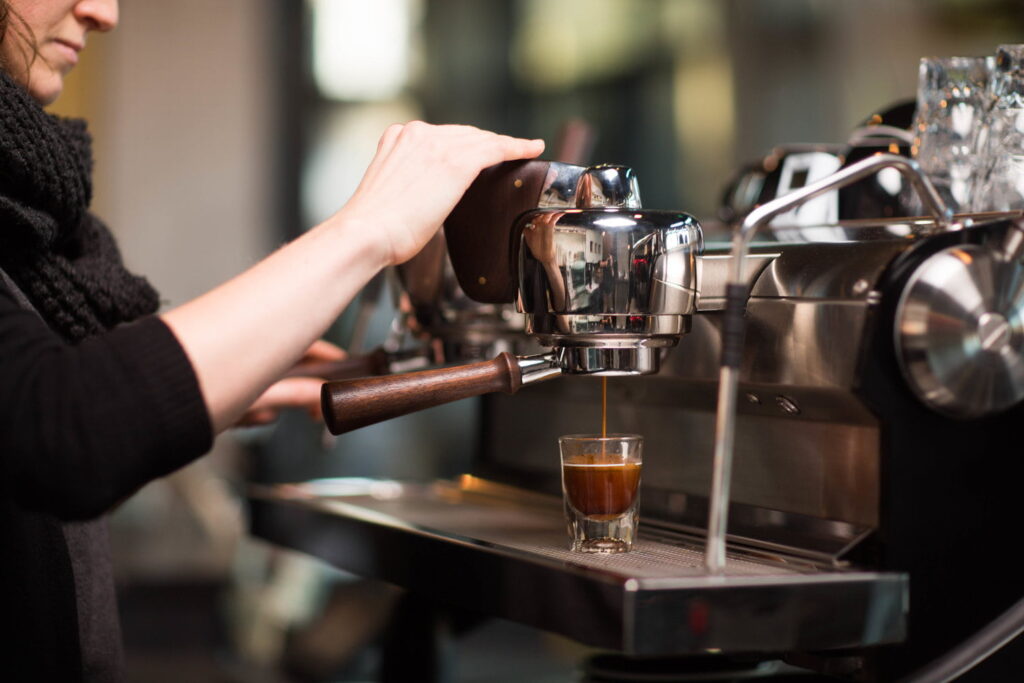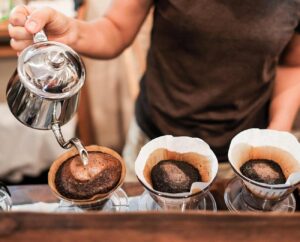An espresso machine is a more specialized piece of coffee-making equipment. It produces a strong and concentrated shot of coffee that can be enjoyed on its own or used as the base for other coffee drinks. It is designed to brew a concentrated and flavorful shot of espresso by forcing hot water through finely ground coffee beans. Espresso machines are available in a variety of styles, from simple manual models to more complex automatic machines.
Espresso is a popular coffee drink that is enjoyed by many around the world and can be found in various cafes, restaurants, and homes.
There are several types of espresso coffee makers available on the market, and they vary in terms of their functionality and the level of control they offer to the user. The most popular types of espresso machines include manual, semi-automatic, automatic, and super-automatic.
Manual Espresso Machines: A manual espresso machine requires the user to manually control the water flow and pressure. These machines are usually the most affordable but require a steep learning curve to master. With a manual machine, the user will have to grind the coffee beans, tamp them, and manually control the water flow and pressure to get the perfect shot of espresso.
Semi-Automatic Espresso Machines: A semi-automatic espresso machine provides more control over the brewing process compared to a manual machine. These machines usually have a pump that automatically regulates the water pressure and flow rate, but the user will still have to grind the coffee beans, tamp them, and start and stop the brewing process.
Automatic Espresso Machines: An automatic espresso machine is more user-friendly and easier to use than a manual or semi-automatic machine. These machines have a built-in grinder, a pump that automatically regulates the water pressure and flow rate, and a mechanism that stops the brewing process once the desired volume of espresso has been reached.
Super-Automatic Espresso Machines: A super-automatic espresso machine is the most advanced type of espresso machine available on the market. These machines have a built-in grinder, a pump that automatically regulates the water pressure and flow rate, and a mechanism that automatically tamps the coffee grounds, brews the espresso, and disposes of the used grounds.
When choosing an espresso coffee maker, there are several features to consider, including:
Size: Espresso machines come in various sizes, so it’s important to choose a machine that fits your space and meets your brewing needs.
Water Tank Capacity: The water tank capacity determines how many shots of espresso you can make before needing to refill the tank. A larger water tank capacity is ideal for those who drink a lot of espresso or have multiple users.
Built-In Grinder: A built-in grinder is convenient as it allows you to grind the coffee beans right before brewing, which ensures maximum freshness and flavor.
Milk Frothing: If you enjoy milk-based espresso drinks like lattes or cappuccinos, you may want to consider an espresso machine that has a built-in milk frother.
Using an espresso coffee maker may seem intimidating at first, but with some practice, it can become a part of your daily routine, and you can display the art of making a good espresso to friends and family. Here are the general steps when using an espresso coffee maker:
Fill the water tank: Fill the water tank with fresh, cold water.
Preheat the machine: Turn on the machine and allow it to preheat for a few minutes. This ensures that the water is at the optimal temperature for brewing.
Grind the coffee: Grind the coffee beans to a fine consistency and tamp them down into the portafilter.
Brew the espresso: Attach the portafilter to the machine and start the brewing process. The machine will automatically regulate the water pressure and flow rate, which will force hot water through the coffee grounds and into the cup.
Froth the milk: If you’re making a milk-based espresso drink, use the milk frother to create frothed milk, and add it to the espresso shot.
- Clean the machine: After brewing, it’s important to clean the machine to prevent any buildup of coffee oils and residue. This involves emptying the used coffee grounds, wiping down the machine, and rinsing any detachable parts.
Conclusion
Espresso coffee makers are a great investment for coffee lovers who enjoy the rich and flavorful taste of espresso. When choosing an espresso machine, consider the features that are important to you, such as size, water tank capacity, built-in grinder, and milk frother. With some practice, you can become a pro at using an espresso coffee maker and enjoy delicious espresso drinks from the comfort of your own home.







נערות ליווי
Itís nearly impossible to find well-informed people for this topic, but you seem like you know what youíre talking about! Thanks
Mtu
Thanks. There are some truly unique coffees becoming more available when you directly interact with, and involve small growers and communities like we do. We are enjoying the learning process as well as these simply outstanding coffees that are not readily available in the regular outlets.